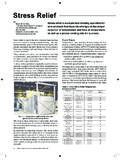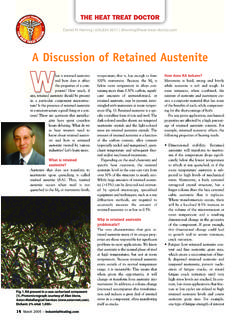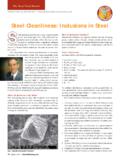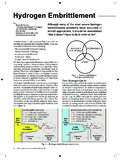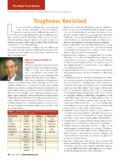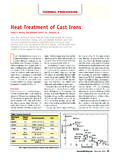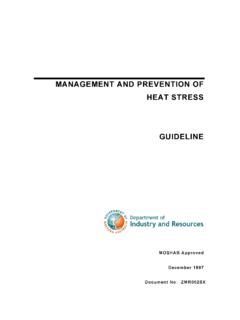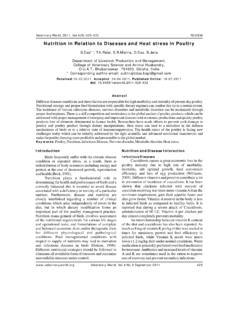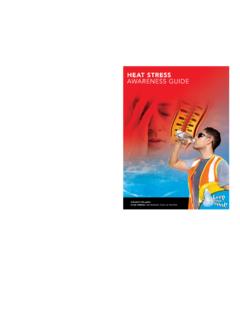Transcription of Testing of Heat-Treated Fasteners - Heat Treat …
1 Testing of Heat-Treated Fasteners by: Daniel H. Herring fastener reliability and performance is assured by The heat Treat Doctor , President Testing . Since heat treatment can have a profound The HERRING GROUP, Inc. Box 884 influence on final properties, it is important to test the Elmhurst, IL 60126-0884 USA. product at this point in the manufacturing process. Richard D. Sisson, Jr. George F. Fuller Professor Center for heat Treating Excellence Director of Manufacturing and Materials Engineering Worcester Polytechnic Institute 100 Institute Road, Worcester, MA 01602 USA. The diversity of fastener types, sizes and end-use applica- tions require a variety of test methods (Table 1 on last page of this article) from simple dimensional checks to rigorous mechanical Testing . Common types of tests include fatigue, Fig. 2 Tensile tensile strength, wedge tensile (10 ), double shear, hardness, Testing apparatus stress rupture, stress durability, pull-out/push-out, vibration, (photo courtesy engagement, wear, microstructure, chemical analysis and of Instron ).
2 Corrosion. Testing should be performed on the raw material, after heat treatment and on the finished product. Torque/Torque-tension. Fasteners are typically installed by applying a torsional force to the head or nut. This force (or seating torque) causes the fastener to stretch and effectively applies a preload to ensure a snug fit between components. One purpose of a torque-tension test (Figure 3) is to determine the appropriate tightening torque required. This type of test will allow the nut factor (sometimes referred to as the torque coefficient or k factor) to be determined as well as the overall coefficient of friction. Similarly one often needs to determine the torque force at which the fastener will fail. By complet- ing several similar tests, the variation in the torque-tension relationship, due to frictional variation, can be established for a given application.
3 Fig. 1 Forged bolts (photo courtesy of Instron ). Fatigue. Fatigue is a measure of the stress that a material can withstand repeatedly without failure. A fatigue failure is Mechanical Test Methods particularly catastrophic because it occurs without warning. In mechanical Testing , Fasteners are analyzed to determine Three basic factors are necessary to cause a fatigue failure: their mechanical properties. Mechanical properties are those associated with elastic or inelastic behavior of a component when force is applied. It involves the relationship between stress and strain. A mechanical test shows whether the material or fastener is suitable for its intended application by measur- ing such aspects of performance as elasticity, tensile strength, elongation, hardness and fatigue limit. Tensile. Tensile Testing of Fasteners (Figure 2) helps us understand the amount of force required to pull the fastener out of the base material.
4 While straightforward, the many shapes and sizes of Fasteners complicate the Testing . High production demands necessitate a large number of tests and potential of violent fractures makes Testing more complicated. Most manu- facturers must not only test for ultimate tensile strength but also perform proof tests and ensure that no permanent deformation has occurred once the proof load is removed. In addition, they Fig. 3 Torsion Testing apparatus must find ways to test for thread quality and head strength. (photo courtesy of Instron ). xx fastener Technology International/February 2010. a maximum tensile stress of sufficiently high value, a large formation of a material while under an applied load (below enough variation or fluctuation in the applied stress, and a suf- its yield point). Stress-rupture is the sudden and complete ficiently large number of cycles of the applied stress.
5 Fatigue failure of a material held under a constant load for a given life tests are performed on threaded Fasteners by alternating period of time at a specific temperature. These tests are used loading and unloading the part. Most Testing is done at more by fastener manufacturers to determine how their products severe strain than its designed service load but usually below will perform when subjected to constant loads at both ambient the material yield strength. and elevated temperatures. Fatigue Testing equipment is usually designed to induce Stress Durability. Stress durability is used to test parts cyclic loading and unloading to a known (peak) stress and that have been subjected to any processing operation ( , measure the number of such cycles to failure of the specimen. electroplating) that may have an embrittling effect. It requires Variants of the test include tensile, bending, and rotating.
6 The loading the parts to a value higher than the expected service average stress at which a steel can withstand 10 million load- load and maintaining that load for a specified time after ing cycles without failure is reported as the fatigue strength which the load is removed and the fastener examined for the (also called the endurance limit). As stress increases, the presence of cracks. number of cycles to failure decreases. Hardness Testing . Microhardness Testing (Figure 5) is Shear Strength. Shear strength is defined as the maximum often done to measure the core hardness of a fastener or load that can be supported prior to fracture, when applied at measure the depth of case hardening. This type of hardness a right angle to the fastener 's axis. Simply stated, it is the test helps characterize the Fasteners durability or wear. For force required to pull the base material in one direction and example, low core hardness measurements may indicate a the top material in the other direction until failure.
7 Modes premature yielding of the fastener leading to a ductile failure. of failure include deformation of the base material ( , the By contrast, high core hardness may indicate the inability to fastener pulls out of the base material) and fastener fracture. properly yield and lead to a brittle type fracture. In either case, Bolted or riveted connections are those that are commonly the integrity of the fastener may be jeopardized. subjected to shear stresses. Unlike tensile Testing , determining the ultimate shear load and detecting specimen failure can be difficult. The test system must be flexible enough to define different end-of-test criteria for each style of fastener . Most, if not all, shear Testing is done on the unthreaded portion of the fastener . Single shear Testing applies a load in one plane and results in the fastener being cut into two pieces, while double shear Fig.
8 5 Micro- (Figure 4) produces three fastener pieces. Single shear values hardness Testing for Fasteners are typically calculated based upon the nominal (photo courtesy body diameter or body shear area. There is a relationship be- of Wilson . tween the tensile strength of a material and its shear strength. Instruments). For example, in alloy steel the shear strength is approximately 60% of its tensile strength. In corrosion resistant steels ( 300-Series stainless steels) the tensile/shear relationship is usually only 50% to 55%. Vibration Tests. Vibration tests are used to determine a Creep and Stress-Rupture. Creep is time-dependent de- fastener 's lifespan, and compare fastener 's self-loosening characteristics under vibratory conditions. A transverse vibra- tion test machine (commonly called a Junker machine) is used to produce a preload decay graph, an indication of resistance to self-loosening.
9 Metallurgical (Structure) Analysis Metallurgical Testing can be performed to evaluate fastener microstructure yielding invaluable information on grain size, surface condition ( , carburization or decarburization), and heat treatment response. The microstructure and grain size are most often influenced by heat treatment. Chemistry. The chemical composition of a steel heat is established at the mill and reported on a material certification Fig. 4 Double sheet issued. It is highly desirable to know not only the prin- shear Testing cipal elements but also the trace elements present before heat apparatus treatment. Grain size, prior processing ( , mill annealing). (photo courtesy and hardenability are also commonly reported. of Instron ). Hydrogen Embrittlement. Steel Fasteners exposed to sources of hydrogen ( electroplating operations) can fail prematurely at stress levels well below the materials yield strength.
10 The effect is often a delayed one meaning that it may occur in service. Higher strength steels are more susceptible February 2010/ fastener Technology International xx Testing of Heat-Treated Fasteners ..continued to hydrogen embrittlement than lower strength steels. As Table 1. Summary of Common Test Methods for Fasteners . a rule of thumb, steels below 30 HRC are considered to Test Method Applicable Specifications be far less susceptible. The problem can be controlled by careful selection of plating formulation, proper plating Chemical Analysis Optical emission spectrochemical analysis ASTM E415/ASTM E1086. procedure, and sufficient baking to drive off any residual Mechanical and Physical Axial tensile strength of ASTM A370/ASTM F606/. hydrogen. Testing and Inspection full-size threaded Fasteners SAE J429/SAE J1216/ISO 6892. Corrosion.
